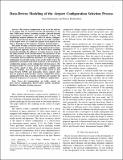| dc.contributor.author | Ramanujam, Varun | |
| dc.contributor.author | Balakrishnan, Hamsa | |
| dc.date.accessioned | 2017-05-05T13:51:10Z | |
| dc.date.available | 2017-05-05T13:51:10Z | |
| dc.date.issued | 2015-04 | |
| dc.identifier.issn | 2168-2291 | |
| dc.identifier.issn | 2168-2305 | |
| dc.identifier.uri | http://hdl.handle.net/1721.1/108688 | |
| dc.description.abstract | The runway configuration is the set of the runways at an airport that are used for arrivals and departures at any time. While many factors, including weather, expected demand, environmental considerations, and coordination of flows with neighboring airports, influence the choice of runway configuration, the actual selection decision is made by air traffic controllers in the airport tower. As a result, the capacity of an airport at any time is dependent on the behavior of human decision makers. This paper develops a statistical model to characterize the configuration selection decision process using empirical observations. The proposed approach, based on the discrete-choice modeling framework, identifies the influence of various factors in terms of the utility function of the decision maker. The parameters of the utility functions are estimated through likelihood maximization. Correlations between different alternatives are captured using a multinomial “nested logit” model. A key novelty of this study is the quantitative assessment of the effect of inertia, or the resistance to configuration changes, on the configuration selection process. The developed models are used to predict the runway configuration 3 h ahead of time, given operating conditions such as wind, visibility, and demand. Case studies based on data from Newark (EWR) and LaGuardia (LGA) airports show that the proposed model predicts runway configuration choices significantly better than a baseline model that only considers the historical frequencies of occurrence of different configurations. | en_US |
| dc.description.sponsorship | National Science Foundation (U.S.) (Grant 1239054) | en_US |
| dc.language.iso | en_US | |
| dc.publisher | Institute of Electrical and Electronics Engineers (IEEE) | en_US |
| dc.relation.isversionof | http://dx.doi.org/10.1109/THMS.2015.2411743 | en_US |
| dc.rights | Creative Commons Attribution-Noncommercial-Share Alike | en_US |
| dc.rights.uri | http://creativecommons.org/licenses/by-nc-sa/4.0/ | en_US |
| dc.source | MIT web domain | en_US |
| dc.title | Data-Driven Modeling of the Airport Configuration Selection Process | en_US |
| dc.type | Article | en_US |
| dc.identifier.citation | Ramanujam, Varun, and Hamsa Balakrishnan. “Data-Driven Modeling of the Airport Configuration Selection Process.” IEEE Transactions on Human-Machine Systems 45.4 (2015): 490–499. | en_US |
| dc.contributor.department | Massachusetts Institute of Technology. Department of Aeronautics and Astronautics | en_US |
| dc.contributor.mitauthor | Balakrishnan, Hamsa | |
| dc.relation.journal | IEEE Transactions on Human-Machine Systems | en_US |
| dc.eprint.version | Author's final manuscript | en_US |
| dc.type.uri | http://purl.org/eprint/type/JournalArticle | en_US |
| eprint.status | http://purl.org/eprint/status/PeerReviewed | en_US |
| dspace.orderedauthors | Ramanujam, Varun; Balakrishnan, Hamsa | en_US |
| dspace.embargo.terms | N | en_US |
| dc.identifier.orcid | https://orcid.org/0000-0002-8624-7041 | |
| mit.license | OPEN_ACCESS_POLICY | en_US |
